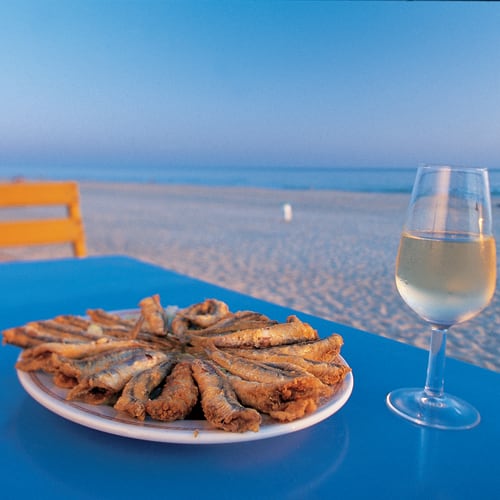Discover Sunny Andalucía
Don Harris | March 2015




Last month I recounted how easy it is to discover amazing jewels of Spanish culture by wandering just a few kilometers from the engaging city of Barcelona. There is so much more you can see by ever so slightly straying off the beaten path.
Today I want to go with you to exotic Andalucía, starting in the ancient city of Sevilla. Yes, there are bullfights, and lavish ferias (fairs) and flamenco dancing, but there is so much more to the land of Sevilla, Córdoba and Granada. I say exotic because, from 711 AD, when Arabs and Berbers from nearby Africa invaded Spain, until 1492 (721 years later) when the Christian forces finally defeated the Muslims at Granada, the Moorish culture was the dominant way of life in much of southern Spain. Over centuries the Arabs, Berbers and Spanish Christians intermarried and quickly became one people – called the Moors.

It was that mix of cultures (not always a happy one) which produced this amazing land and people. Their warmth and hospitality is legendary, their social values are inimitable. I know it may be a cliché, but they truly work to live, rather than living to work. They are industrious when appropriate, and at the same time, they are gracious - placing human values first.
First, getting there. If you choose to drive from the Madrid airport to Sevilla, the heart of Andalucía, it is a long haul. After completing an overnight flight from the States, you may want drive south and stop at the amazing Parador in Jaén – a castle-hotel dramatically built on a cliff overlooking thousands of acres of olive groves. Then you can head for Carmona and Sevilla the next day.
Another less demanding option is to catch the sleek bullet train called the AVE all the way from Madrid to Sevilla, where we rent a car upon arrival. But the simplest option is to book your flight from your local airport, via Madrid to the handy Sevilla airport, where you pick up your luggage and rental car and make a 30-minute drive to Carmona on the road to Córdoba. By mid-afternoon you can be comfortably settled in Casa de Carmona, our favorite hotel, originally a 15th century palace (and quite reasonably priced). After a refreshing siesta you will be ready for an evening sherry and some tapas.

The next morning you return to the glittering city of Sevilla with its Santa Cruz Sephardic quarter and the fascinating gypsy section of Triana across the river. Unless you want to immerse yourself in the ambiance of Sevilla for a long period, you can catch the highlights in a day. There is the World Heritage Cathedral-Mesquita, originally designed to be a mosque in the 13th century (with Columbus’s tomb) and New World golden altarpiece. You can climb up the towering Giralda bell tower, still present from the original mosque. Around the corner is the amazing Moorish Alcázar fortress whose architect is also responsible for much of the Alhambra design in Granada.
When you are filled to the brim with Sevilla sights, return to the classic town of Carmona. It has a wonderful Parador hotel built directly in a castle that has battlements built by Pedro the Cruel, with a breathtaking view of the plains. Carmona has a lovely main square and the ancient streets make for a pleasant stroll back to Casa de Carmona. There you can immerse yourself in the ambiance of Spain with nary a tourist in sight. What could be more soothing than to sip a drink and nibble Manchego cheese and olives in its large courtyard of palms. Let me know if you plan to visit there and I will alert our good friend Felipe, the owner who speaks flawless English (he went to MIT!)
The next day you have two options: The first is a one hour freeway ride south to the three famous sherry towns. The first is Sanlúcar de Barrameda, the ultimate laid-back seaside town next to Doñana - with a wildlife preserve complete with pink flamingos feasting on krill. Another is Jerez de la Frontera, the elegant sherry town with an incomparable horse feria each May. During the fair the carriages full of revelers in period dress reminds me of a flamenco version of Gone With the Wind! Finally there is El Puerto de Santa María, a quiet town on the bay of Cádiz, full of fresh seafood and great wine.

I encourage you to make a visit to a sherry bodega in each of these towns. Because of the differences in climate and closeness to the sea, each town boasts unique sherry wines with an amazing variety of tastes. (For the uninitiated, most sherry is not that intolerably sweet wine you may be imagining – most sherry is subtle and quite dry). The bodegas are very welcoming and there is nothing like strolling through a room filled with giant oak barrels holding thousands of gallons of sherry. The bright aroma fills the air, a scent that always transports us back to the region. One of our favorite bodegas is Gutiérrez Colosia in El Puerto by the waterfront. If you stop by, be sure to let Carmen and Juan Carlos know that we sent you!
From El Puerto you can take a brief ferry ride to Cádiz, the oldest city in Europe. The locals say it was founded 3,000 years ago by Hercules. The 3,000 years is correct since it was founded by the Carthaginians, but I am not sure of the Hercules part - he was quite preoccupied with his Labors. The municipal market, near the cathedral, is truly awesome with acres and acres of fresh fish and other amazing creatures of the deep. Cádiz is surrounded by many Atlantic beaches and sports a brand new glistening Parador hotel.
Another journey from Carmona is to drive east one hour to Córdoba, stopping by for a visit to the amazingly restored Almodóvar castle. In its glory days Córdoba was the center of Islamic/Moorish culture and achievement - centuries more advanced than Paris or London. There you can visit a full scale cathedral tucked inside a massive mosque, one of the all-time architectural jewels of Islam. I could linger there for hours. Next to it are the colorful white washed buildings of the Jewish quarter, home of Maimonides. In May, you can witness the Feria de Patios where you wander through private courtyards bedecked with flowers.
An hour and a half south of there you can be in Priego de Córdoba, one of the hilltop white cities of Andalucía, where I can introduce you to Fermín and Aixa Rodríguez. Over some wine and tapas they will show you how they produce La Tienda’s most popular olive oil: Señorío de Vizcántar. Their little daughter Sofía is as bright as she is cute.
I could go on and on: Ronda, Arcos de La Frontera, Medina-Sidonia, El Rocío, Grazalema and other jewels are nearby, and Granada is just an hour or two further. A quick Google search can uncover mountains of information about these towns that we only dreamed of having when I first started traveling Spain. The areas I have touched upon are all within a two to three hour radius of beautiful Sevilla. Next time you travel to Spain, map out an itinerary that will take you off the beaten path – it will make all the difference!

